
Palazzo Davanzati is a palace in Florence, Italy. It houses the Museum of the Old Florentine House.

Palazzo Davanzati is a palace in Florence, Italy. It houses the Museum of the Old Florentine House.
Palazzo Davanzati was erected in the second half of the 14th century by the Davizzi family, who were wealthy members of the wool guild. In 1516 it was sold to the Bartolini; in 1578 it was bought by the Davanzati family, who also were also rich merchants, in whose possession it remained until 1838. After the suicide of Carlo Davanzati, it was split into different quarters and modified. After escaping the numerous demolitions of 19th century Florence, it was bought by Elia Volpi, an antiquarian, who restored it in (his impression of) the original style.
In 1910, Volpi opened the building as a private museum (Museo Privato della Casa Fiorentina Antica). The contents of this museum kept changing as Volpi sold the furniture at auctions, including a major one in 1916 in New York. In the 1920s, Egyptian antique dealers Vitale and Leopoldo Bengujat acquired the building and its contents. In 1951 it was purchased by the Italian state and kept open as a museum. By 1995 the museum needed to be closed for major structural restorations; the museum was partially reopened in 2005 with the ground floor and first floor accessible; by 2012, all the floors were again open to visitors.
The palace consists of a façade that unifies a grouping of earlier, medieval tower homes that the owner purchased with the intent to put them together. It is constructed in sandstone, with three large portals on the horizontal axis, and three stories of mullioned windows. The top-most floor has a loggia that was added in the 16th century and which is supported by four columns and two pilasters. The façade displays the Davanzati coat of arms and has traces of other decorations.
The interior courtyard has 14th century-style arches, vaults, and capitals.
The following rooms can be visited:
Entered through one of three large portals. This large room was used to conduct business. Presently it used to display objects and information related to the history of the building.
All rooms of the building communicate onto hallways that open onto this central courtyard.
This large room was also used for conducting business. Its large windows are located street-side. There are three square holes with wooden covers that align with the openings of the atrium below; culminating in a street view, these holes were used to observe who was walking in, and possibly for defense purposes. The room is now set up as a museum with various 16th-century objects on display.
The so-called Sala dei Pappagalli has wall paintings designed to look like patchwork wall-hangings lined with miniver, with motifs of parrots painted or embroidered on the blocks. These paintings are much restored and so may not look like the original frescoes. A large fireplace dominates this room. On display is maiolica from Montelupo.
A small room with indoor plumbing.
This room, which does not retain any of its original wall decoration, was probably a study. Objects on display include a forziere (locking chest), cassone, several small sculptures, and paintings.
The Sala dei Pavoni's frescoes show instead a false-geometrical tapestry and a row of coat of arms of families allied with the Davizzi. It is currently set up with a bed and cradle. There is a small ensuite bathroom.
The bedroom of the second floor is called the Chatelain of Vergy in honor of the frescoes inspired by The Châtelaine de Vergy , [1] a medieval romance full of love, adventure and death. In the same bedroom you can see a beautiful "Desco da Parto" painted by Scheggia, Masaccio's brother.

Located on the third floor are the Camera delle Impannate, another bedroom, and the kitchen. The impannate were cotton or linen textile panels that were dipped in colored wax and put in a wood frame to be inserted in the windows as a substitute for glass, which was very expensive at the time.
The kitchen is at the top floor because the hot air rising from cooking stayed away from the lower living spaces in the heat of summer, and also to minimize damage in the event of an out-of-control fire. The room features a fireplace with bellows and two turnspits, a wooden bread-kneading machine, a metal butter churn and other tools dating from the Renaissance period or later.

Palace of Fontainebleau, located 55 kilometers southeast of the center of Paris, in the commune of Fontainebleau, is one of the largest French royal châteaux. It served as a hunting lodge and summer residence for many of the French monarchs, beginning with Louis VII. Francis I, Henry II, Louis-Philippe, Napoleon Bonaparte and Napoleon III. Though the monarchs only resided there for a few months of the year, they gradually transformed it into a genuine palace, filled with art and decoration. It became a national museum in 1927 and was designated a UNESCO World Heritage Site in 1981 for its unique architecture and historical importance.

The Doge's Palace is a palace built in Venetian Gothic style, and one of the main landmarks of the city of Venice in northern Italy. The palace was the residence of the Doge of Venice, the supreme authority of the former Republic of Venice. It was built in 1340 and extended and modified in the following centuries. It became a museum in 1923 and is one of the 11 museums run by the Fondazione Musei Civici di Venezia.
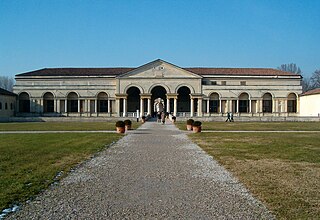
Palazzo del Te, or simply Palazzo Te, is a palace in the suburbs of Mantua, Italy. It is an example of the mannerist style of architecture, and the acknowledged masterpiece of Giulio Romano.

The Villa Farnese, also known as Villa Caprarola, is a pentagonal mansion in the town of Caprarola in the province of Viterbo, Northern Lazio, Italy, approximately 50 kilometres (31 mi) north-west of Rome, originally commissioned and owned by the House of Farnese. A property of the Republic of Italy, Villa Farnese is run by the Polo Museale del Lazio. This villa is not to be confused with two similarly-named properties of the family, the Palazzo Farnese and the Villa Farnesina, both in Rome.

Ca' Rezzonico is a palazzo and art museum on the Grand Canal in the Dorsoduro sestiere of Venice, Italy. It is a particularly notable example of the 18th century Venetian baroque and rococo architecture and interior decoration, and displays paintings by the leading Venetian painters of the period, including Francesco Guardi and Giambattista Tiepolo. It is a public museum dedicated to 18th-century Venice and one of the 11 venues managed by the Fondazione Musei Civici di Venezia.

The Palazzo Vecchio is the town hall of Florence, Italy. It overlooks the Piazza della Signoria, which holds a copy of Michelangelo's David statue, and the gallery of statues in the adjacent Loggia dei Lanzi.

The Palazzo Pitti, in English sometimes called the Pitti Palace, is a vast, mainly Renaissance, palace in Florence, Italy. It is situated on the south side of the River Arno, a short distance from the Ponte Vecchio. The core of the present palazzo dates from 1458 and was originally the town residence of Luca Pitti, an ambitious Florentine banker.

The Palazzo Medici, also called the Palazzo Medici Riccardi after the later family that acquired and expanded it, is a Renaissance palace located in Florence, Italy. It is the seat of the Metropolitan City of Florence and a museum.

The Palace of Ajuda is a neoclassical monument in the civil parish of Ajuda in the city of Lisbon, central Portugal. Built on the site of a temporary wooden building constructed to house the royal family after the 1755 earthquake and tsunami, it was originally begun by architect Manuel Caetano de Sousa, who planned a late Baroque-Rococo building. Later, it was entrusted to José da Costa e Silva and Francisco Xavier Fabri, who planned a magnificent building in the modern neoclassical style.

The Palazzo Ducale di Mantova is a group of buildings in Mantua, Lombardy, northern Italy, built between the 14th and the 17th century mainly by the noble family of Gonzaga as their royal residence in the capital of their Duchy. The buildings are connected by corridors and galleries and are enriched by inner courts and wide gardens. The complex includes some 500 rooms and occupies an area of c. 34,000 m2, which make it the sixth largest palace in Europe after the palaces of the Vatican, the Louvre Palace, the Palace of Versailles, the Royal Palace of Caserta and the Castle of Fontainebleau. It has more than 500 rooms and contains seven gardens and eight courtyards. Although most famous for Mantegna's frescos in the Camera degli Sposi, they have many other very significant architectural and painted elements.
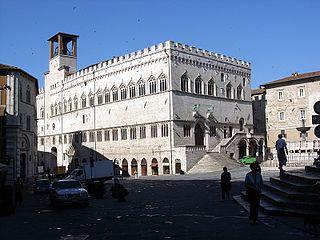
The Palazzo dei Priori or comunale is one of the best examples in Italy of a public palace from the communal era. It is located in the central Piazza IV Novembre in Perugia, Umbria. It extends along Corso Vannucci up to Via Boncambi. It still houses part of the municipality, and, on the third floor, the Galleria Nazionale dell'Umbria. It takes its name from the Priori, the highest political authority governing the city in the medieval era.

The Palazzo Grimani of Santa Maria Formosa is a State museum, located in Venice in the Castello district, near Campo Santa Maria Formosa.

The Palazzo Comunale, also known as the Palazzo del Popolo of San Gimignano has been the seat of the civic authority in the comune since the 13th century. It is located on the Piazza del Duomo close to the Collegiate Church of the Assumption of the Blessed Virgin Mary. The building and Collegiate Church are at the heart of the medieval town, and are part of the UNESCO World Heritage Site of the "Historic Centre of San Gimignano".

The Royal Palace of Milan was the seat of government in the Italian city of Milan for many centuries. Today, it serves as a cultural centre and it is home to international art exhibitions. It spans through an area of 7,000 square meters and it regularly hosts modern and contemporary art works and famous collections in cooperation with notable museums and cultural institutions from across the world. More than 1,500 masterpieces are on display annually.
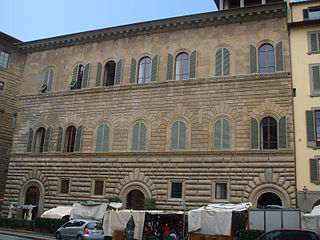
Palazzo Gondi is a palace in Florence, Italy, located a block from Piazza della Signoria. It was built in 1490 under design by Giuliano da Sangallo, who was inspired by other major works of stately buildings in the city, such as Palazzo Medici and Palazzo Strozzi. Among the elements borrowed from these earlier works are the cube-shape set around a central courtyard, the ashlar sloping on each of three floors, and the arched windows.
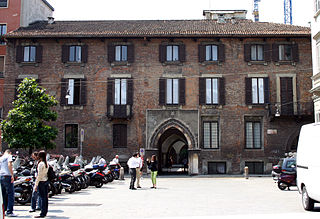
Palazzo Borromeo is a 14th-century building located at piazza Borromeo 12 in Milan, region of Lombardy, Italy. It was built as the home and business headquarters of the Borromeo family, merchant-bankers from Tuscany. Some of the building complex was badly damaged during World War II in Allied bombings of 1943 but was reconstructed and restored to its 15th-century appearance. It contains an important fresco cycle from the 1440s and is one of the finest examples of a Milanese patrician palace from the early Renaissance.
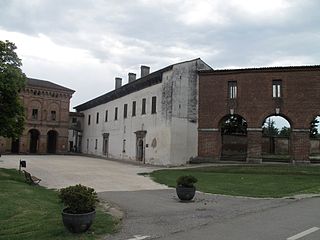
The Galleria degli Antichi and the Palazzo del Giardino are adjacent, contemporaneous, Renaissance-style buildings located on Piazza d`Armi #1 in Sabbioneta, in the Province of Mantua, region of Lombardy, Italy. Prior to 1797, the buildings were connected to the Rocca or Castle of Sabbioneta, and the gallery once housed the Gonzaga collection of antique Roman statuary and hunting trophies. While the architectural design of the gallery is striking, the richness of the interior decoration of the palazzo is also dazzling.

The Palazzo San Sebastiano is a 16th-century palace in Mantua. Built by the Gonzaga family, since 19 March 2005 it has housed Mantua's city museum.

The Palazzo del Giardino or Palazzo Ducale del Giardino is a historic palace in the Parco Ducale in Parma. It is not to be confused with the official Parma residence of Marie Louise, Duchess of Parma between Palazzo della Pilotta and Palazzo della Provincia in what is now known as piazzale della Pace - she also lived at the Ducal Palace of Colorno and in the Casino dei Boschi in Sala Baganza. The main Ducal Palace in Parma, the Palazzo della Pilotta and the Reinach Theater were all destroyed in an early morning air raid on 13 May 1944, carried out by the 465th Heavy Bombardment Group of the US Airforce, 781st Squadron, which dropped 9 GP bombs on the city centre.

The Palazzo dei Priori is a Gothic-style monumental civic building in the center of the town of Volterra, located on the Piazza dei Priori, also known as Piazza Maggiore. The imposing 13th-century stone building once the office of appointed town magistrates, still has offices of the local commune, including the communal council, for Volterra, province of Pisa, region of Tuscany, Italy.